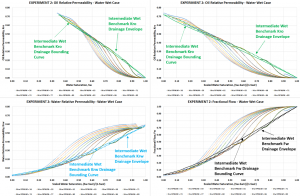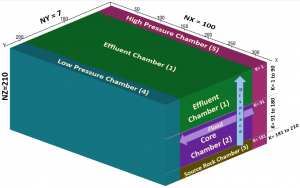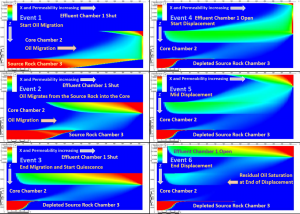
- This event has passed.
SPE APOGCE conference preview – A Digital Core Laboratory Characterising Oil Water Transition Zones
November 17, 2020 @ 8:00 am - November 19, 2020 @ 5:00 pm

| Paper Number | : | SPE-202248-MS |
| Paper Title | : | A Digital Core Laboratory Characterising Oil Water Transition Zones |
| Author Block | : | G.R. Morrison, Woodside Energy Ltd. |
APOGCE Conference 2020 registration:
https://www.spe-events.org/apogce2020/home
Abstract
A multi-chamber, finite-difference dynamic model assumed pore-scale reservoir properties (Table 1) and replicated laboratory processes to determine oil-water transition zone characteristics: (1) imbibition residual oil saturation to water flood (distributed as a function of rock properties); (2) imbibition oil-water relative permeability (according to both steady-state and unsteady-state calculations); and, (3) microscopic oil recovery factor as a function of height above free water level. A priori, scaled capillary pressure hysteresis and segregated flow conditions governed pore-scale flow behaviour (initial mobile saturation scaled 0-1) assuming a pipeline network analogue. Although an oil-water system was modelled the process could be extended to other fluid phases.
The dynamic model was divided into five chambers replicating two experiments (Figure 1). Flow between chambers was regulated by transmissibility multipliers (open/shut). Replicating a core displacement experiment, an oil source rock “drained” (flooded) the central core chamber to form the oil-water transition zone; water then imbibed into the core chamber displacing mobile oil into a shallower effluent chamber; capillary pressure hysteresis defined the imbibition residual oil saturation to water flood (Figure 2). In a second experiment, the central core chamber was subdivided into zones, each comprising five model layers, and the imbibition oil-water relative permeability was determined by flooding the quiesced core chamber situated between high/low-pressure chambers (source/sink). Both steady-state and unsteady-state relative permeability were determined across the oil-water transition zone.
The Digital Core Laboratory (DCL) determined the distribution of imbibition residual oil saturation as a function of: wettability assumption; rock properties; and, proximity to the free water level. For a range of wettability assumptions, imbibition oil-water relative permeability was determined across the transition zone, on a zonal basis, from top core chamber (top reservoir) down to the free water level (Figure 3).
Summary of Results: (1) The imbibition residual oil saturation (ISorw) decreased with depth toward the free water level, while the drainage irreducible water saturation (Swir) increased with depth; (2) ISorw was found to be strongly influenced by the wettability assumption, contrasting with the uniformity of Swir; (3) Microscopic oil recovery factor was determined across the transition zone as a function of both proximity to the free water level and the wettability assumption; except for the oil-wet case, microscopic oil recovery factor increased with depth toward the free water level.
The novel approach was the multi-chambered design of the finite difference model forming a Digital Core Laboratory (DCL). Tuning the model to a Special Core Analysis (SCAL) data set, with the objective of filling SCAL data gaps, is expected to be one application.
Table 1 – Pore-Scale Properties and Processes Mapped to Finite Difference Simulation Parameters
Figure 1 – The Multi-Chamber Digital Core Laboratory (DCL)
Figure 2 – Experiment-1: ISorw by Displacement XZ Cross-Section (Red-Green is Oil Saturation, Blue is Water)
Figure 3 – Experiment-2: Transition Zone Relative Permeability for the Water-Wet Case (USBM WI = +1)


